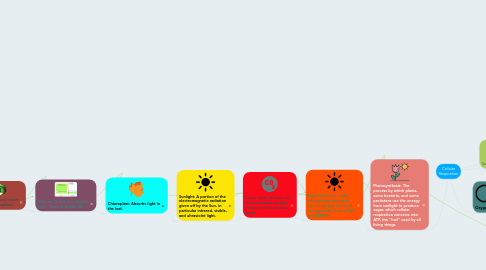
1. Photosynthesis: The process by which plants, some bacteria, and some protistans use the energy from sunlight to produce sugar, which cellular respiration converts into ATP, the "fuel" used by all living things.
1.1. Light Reactions: Light energy from the sun is converted into chemical energy in the form of ATP and NADPH.
1.1.1. Calvin Cycle: A series of chemical reactions that produce a three-carbon sugar.
1.1.1.1. Sunlight: A portion of the electromagnetic radiation given off by the Sun, in particular infrared, visible, and ultraviolet light.
1.1.1.1.1. Chloroplast: Absorbs light in the leaf.
2. Glycolysis: Organic compounds (Sugar) are converted to pyruvic acid, ATP, and NADH.
2.1. Pyruvic Acid: Organic acid that occurs as an intermediate in many metabolic processes, especially glycolysis.
2.1.1. Aerobic Respiration: If there is oxygen, pyruvic acid is then broken down and NADH is used to create ATP.
2.1.1.1. Oxygen
2.1.1.1.1. Krebs Cycle: Creates 2 ATP
2.1.1.1.2. Heterotrophs: Animals and other organisms that must get their energy from food.
2.1.2. Fermentation: If no oxygen is present.
2.1.2.1. No Oxygen
2.1.2.1.1. Lactic Acid: An enzyme coverts pyruvic acid to lactic acid
2.1.2.1.2. Ethyl Fermentation: Plant cells and unicellular organisms use alcohol fermentation to create ethyl alcohol.
2.1.2.1.3. Autotrophs: Organisms that use energy from the sunlight or chemical bonds in inorganic compounds to make organic compounds.
2.1.3. Pyruvate 1/2 piece
2.1.3.1. Mitochondria

